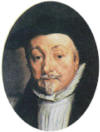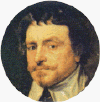|
Charles I. 1625 – 30 Jan 1649.
There were many undercurrents at work concerning religion
and the economic state of the country but Charles I
exacerbated matters by maintaining a closed court. Access
to him personally was strictly maintained which increased
the isolation of his natural courtiers. The perception
certainly grew that he was greatly influenced by his
Catholic wife, Henrietta Maria which had been arranged by
the Anglo French Treaty of 1624. She kept her Catholic
practices, established Catholic chapels and a house
of Capuchin monks in London. Increasingly there seemed to
be more Catholic influence at Court including the Papal
agents Gregorio Panzani and George Con. Catholic chapels
appeared at the residences of ambassadors which were open
to the public. This only exacerbated the fears of people
like John Pym, a prominent Member of Parliament, who had
long suspected a return to Catholicism and absolutism.
It was the drive of the Puritans for reformation of the
Church of England and their opposition to episcopacy and
its trappings, that forced issues of parliamentary
democracy and the Civil Wars
Charles I pursued the same policies as his father but
with greater force and venom in all of the three kingdoms.
A false start was his revocation of land grants which put
the nobility, the main holders of church lands, on alert.
The English Petition of Right in 1628
protesting against his autocratic ways marked a watershed
in his relations with that Parliament. With the cessation
of war on the continent and not requiring money to pursue
it, he resorted to his `personal rule`, treating
Parliament with contempt. A Grand Remonstrance in 1641 and
his attempt to arrest the Five Members (including the
Leader of the Puritan opposition, John Pym) in 1642 ended
in the raising of the royal standard at Nottingham in
August 1643 and Civil War.
 Aided Aided
by Archbishop Laud in England, Thomas Wentworth in
Ireland, and a docile Privy Council in Scotland, Charles
pursued his attack on the institution of the Presbyterian
Church, and nonconformity throughout the three kingdoms.
This took the form of the Arminian policies of Archbishop
Laud and his desire to restore “the beauty of Holiness”.
The enforced changes included relocation of the
altar and enclosing within rails; use of vestments; bowing
at the name of Jesus; taking the Communion on the knees;
stained glass windows in churches; and compulsory
attendance at church with penalties in default. Further
changes saw the status of clerics enhanced with their
appointment to civil posts such as magistrates. The people
generally, resented the changes and the intervention of
bishops in their life style. This gave rise to the `root
and branch` petitions of 1640 that sought the
abolition of episcopacy in England.
In Scotland the appointment of bishops to the Privy
Council in 1634 indicated the way things were going as
conformity and uniformity were forced on the church and
then the people. In this Charles sought to bring the ministers of Edinburgh under his control by taking over the payment of their stipends. Hitherto they had been paid by the Town Council, but on 18 March 1634 an Act of the Privy Council implemented a local tax on the indwellers (residents) of Edinburgh based on the property – rates as we know it today. This raised £192,118.5.0d Scots in 1635. Whether this large sum was actually disbursed on the stipends must be uncertain, as it would have been a honey pot for Archbishop Laud and the King to dip into.
There soon followed Laud`s Liturgy in
1637; and Jenny Geddes` stool flying through the air in St
Giles Cathedral; the National
Covenant in February 1638 and the General Assembly in
Glasgow in the November and December. Charles was probably
ill advised (misrepresentation) about the strength of feeling in Scotland; and
his proclamation in February 1639 to the northern shires
of England that the Scots intended to invade was a huge
mistake. The people were aware that Parliament did not
approve of nor had it subsidised the planned war. As a
consequence they reluctantly assembled and the funds in the war chest
were very small. In the event the two
Bishops Wars ended in
stalemate with Charles obliged to negotiate treaties. The
wars gained nothing save acrimony and led to renewal of
Civil War in England and the three kingdoms.
In Ulster the bishops of the Episcopal Church of Ireland
shrugged off the accommodation that had existed for two
decades under a benevolent Archbishop Ussher and
began to insist on compliance with episcopacy. This
resulted in several prominent ministers – Blair and
Livingstone among them, being forced to return to
Scotland. The imposition of the Black Oath in 1639
 placed placed
a strangle hold on the nonconformist churches and their
ministers. The harsh policies of Wentworth, who had sought
to relocate the influential Presbyterians to Kilkenny and
Tipperary, extended to the land owners who risked
forfeiture of their estates if they could not prove
ownership. This included the Old English settlers who had
difficulty in proving their title from Elizabethan times,
which contributed to their joining with the Irish in the
later rebellion. The disruption caused by these policies
and general unease because of the Bishops Wars in
Scotland, encouraged rebellion and the resultant massacres
of Protestants in 1641. Wentworth further compounded
matters by raising an army ready for use by Charles on the
mainland. Sir John Clotworthy a wealthy Ulster
settler, reported to the English Parliament in
November1640 that there were two armies in Ireland. The
new one was 10,000 strong, well paid and mainly Catholics,
and the old Protestant army that was a year in arrears of
pay. Wentworth was impeached within days and charged with
treason.
…he
had a design to bring over the Irish army into England. ..
popery had flourished during his rule in Ireland without
constraint, he had stirred up enmity between England and
Scotland and had incensed the king against parliaments.
The Solemn League and Covenant
in 1643 joined Scotland and the English Parliamentarians
in a political agreement against the king. The Civil Wars,
mainly in England, were Charles` downfall, although a
brilliant campaign by the Marquis of Montrose almost had
Scotland on its knees. The battle of Naseby on 14 June
1645 settled the military issues and in May 1646 Charles
surrendered to the Scottish army, anticipating that they
were more likely to leave his head on his shoulders.
Handed over to the Parliamentarians on payment of the
Scottish armies costs, Charles became the guest of the New
Model Army. Oliver Cromwell was now leading a `Godly Army`
with the troops supplied with a copy of the Soldiers
Catechism. Charles eventually escaped to the Isle of Wight
where he was approached, in December 1647, by Scottish
nobles led by the Duke of Hamilton. The meeting resulted
in `The Engagement`,
which was an ill advised attempt to recover his English
Crown by force using Scottish troops; and an end to all
aspirations at Preston in August
1648. Charles` end on the executioner`s block was now a
political inevitability.
Charles II King of Scotland Feb 1649 – Sep 1651
|